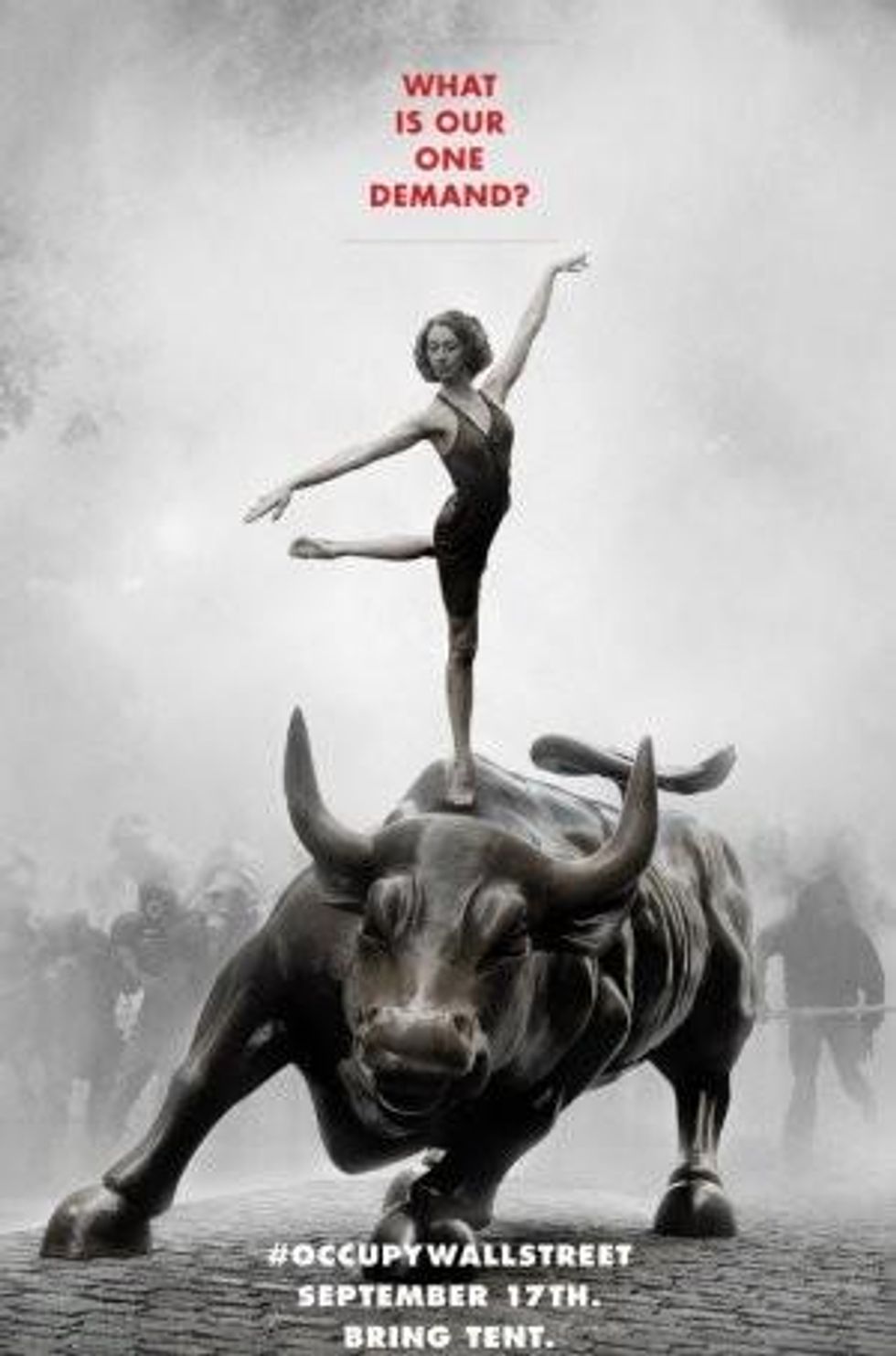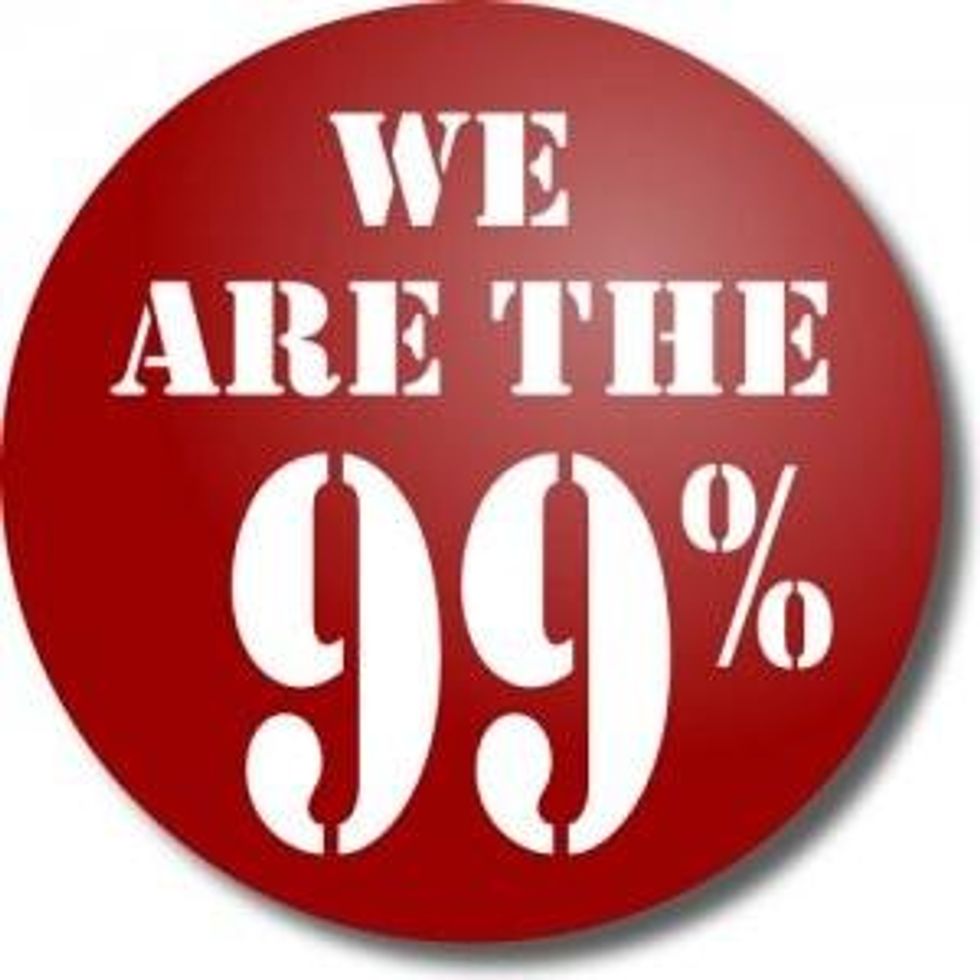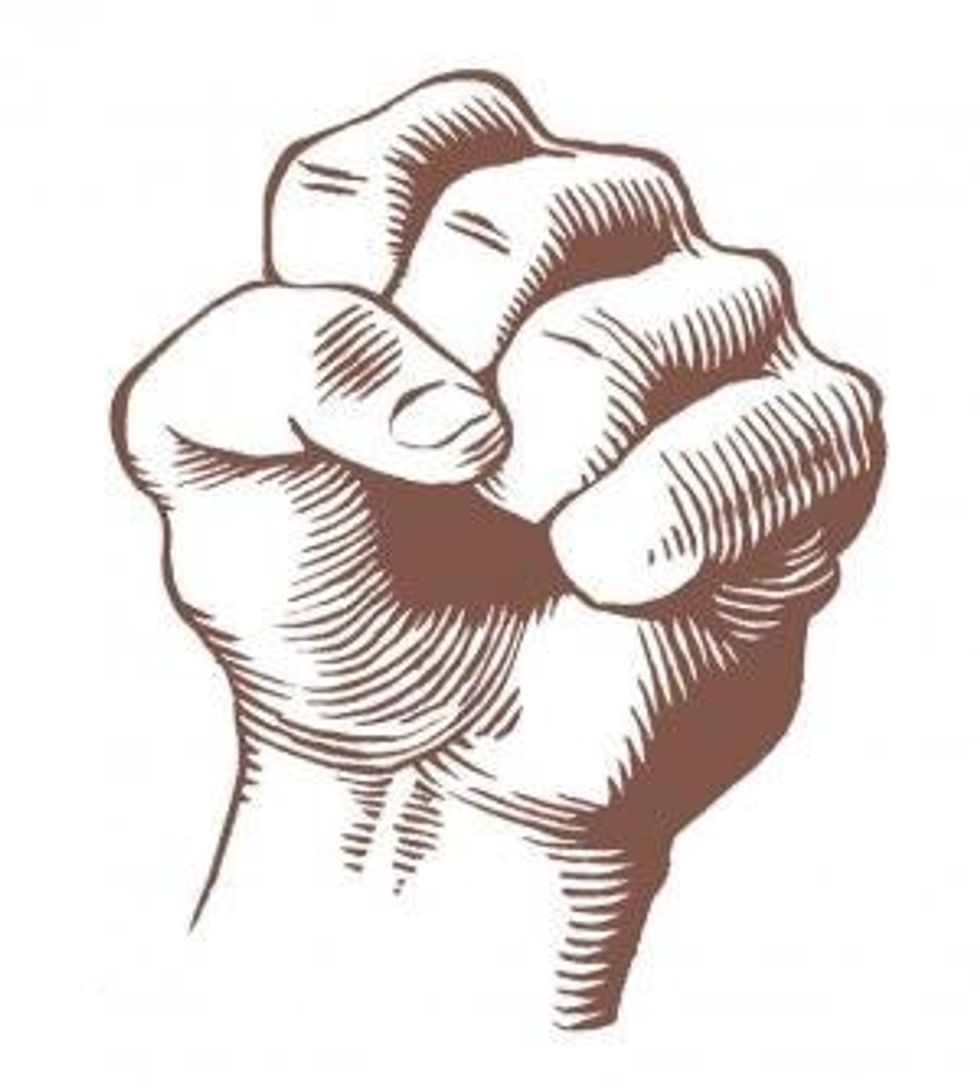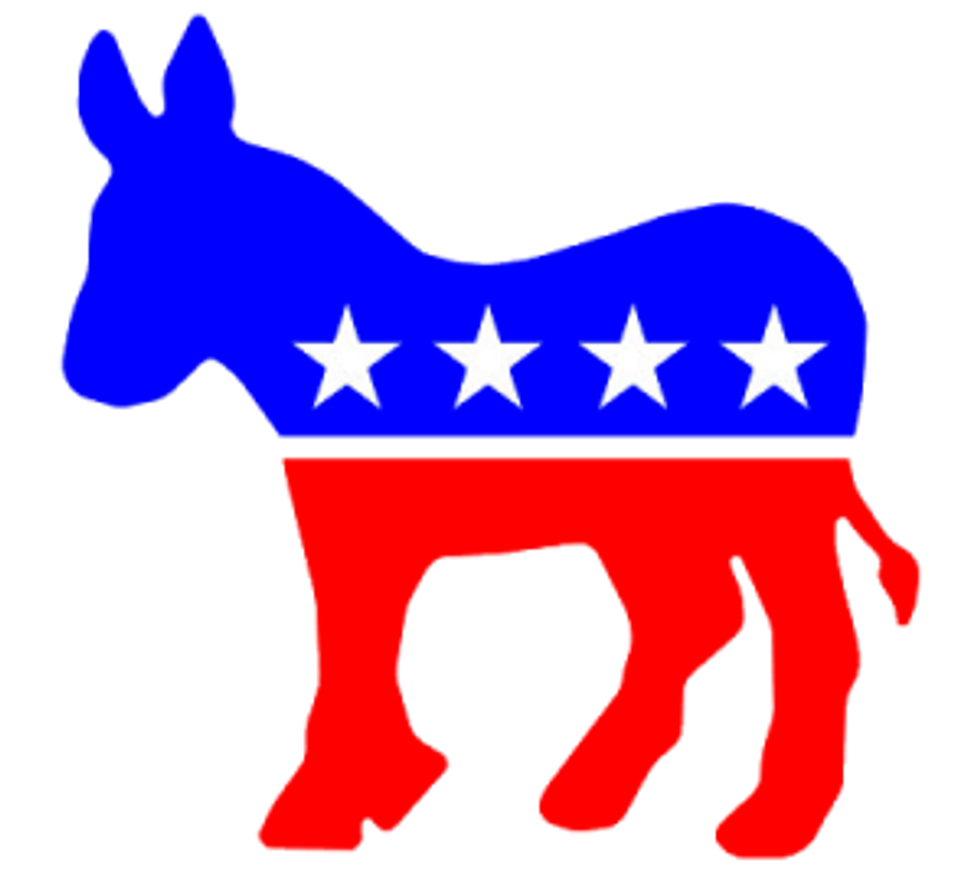By all measures the Occupy movement is a powerful brand. It has thousands of spin-offs such as occupy our homes, occupy money, occupy the hood, occupy gender equality and occupy the food system. It has powerful name recognition, snagging "word of the year" honors in 2011. And now ardent supporters are manning the ramparts to defend its integrity.
Adbusters, the culture-jamming magazine that helped spark Occupy Wall Street, is accusing unions and liberal groups clustered under the banner of the 99% Spring of tarnishing Occupy's sterling name. Launched in February by groups like Greenpeace, the Service Employees International Union, MoveOn and Rebuild the Dream, the 99% Spring announced it would train 100,000 people in April for "sustained nonviolent direct action" against targets like Verizon, Bank of America and Walmart.
These groups, bellowed Adbusters in an online missive "Battle for the Soul of Occupy," are "the same cabal of old world thinkers who have blunted the possibility of revolution for decades." Adbusters fingered MoveOn as one of the primary saboteurs of Occupy, and linked to an article in Counterpunch that claims the 99% Spring "is primarily about co-option and division, about sucking a large cross-section of Occupy into Obama's reelection campaign, watering down its radical politics, and using these mass trainings as a groundwork to put forward 100,000 'good protesters' to overshadow the 'bad protesters.'"
It's a fiery broadside, but there's little evidence to back it up. I queried occupiers from San Francisco, Atlanta, Los Angeles, Little Rock and New York who joined 99% Spring trainings and not one witnessed election-year politicking. Others stressed the coalition includes organizations that would bolt if it was promoting the Democrats. One core organizer of the 99% Spring who preferred to remain anonymous blew his stack when I asked if there weren't legitimate reasons for occupiers to be suspicious of the effort. "Why don't people look at the fact that MoveOn, this huge organization that has set much of the tone for the progressive movement for the last 10 years, is now trying to engage in a radical culture shift by moving its members from clicktivism to getting them to put their bodies on the line in nonviolent street protests and militant eviction defenses in their neighborhoods. Maybe Occupy is worried about its own viability."
Some observers go further, claiming that Occupy is the one co-opting MoveOn. Josh Harkinson in Mother Jones writes: "It seems that America's best-known progressive fundraising organization is now taking its cues from Occupy Wall Street." Nathan Schneider, writing in Waging Nonviolence, takes a more nuanced approach by concluding that while the 99% Spring is indeed co-optation, there is also an opening. Because the thousands who participated in the 99% Spring are a juicy target, He argues that Occupy should be asking how to "turn these people's attention to structures of oppression, rather than to stump speeches and delegates?" Schneider gives voice to the many Occupy activists who want to engage with broader forces. As one activist observes, "The worst thing we could do right now is make Occupy Wall Street into a small 'radicals only' space."
But the real story is how the main groups behind the 99% Spring - such as MoveOn and Rebuild the Dream - have created a meta-brand known as the "99% Movement" that encompasses a product line that includes 99% Power, 99% Candidates, 99% Uniting, a 99% Voter Pledge, and events like "All in for the 99%" and "99% Spring Bank Protests." (Rebuild the Dream, MoveOn and SEIU are sponsors of nearly every formation.) Broadening the coalition to include radical left organizations that reject electoral politics is a sophisticated way to enhance the overall brand. Such groups can feel confident they are maintaining their independence from elections by participating in the 99% Spring but they are still building the 99% brand, which will then be used in forms like the 99% voter pledge and 99% candidates to boost the Democratic Party's fortunes come fall.
Additionally MoveOn and Rebuild the Dream are not being entirely forthright about how they are using the 99% Movement to rebrand existing projects. The 99% Candidates are repackaged "American Dream candidates" that were rolled out last October. The voter pledge "has been based in part on the Contract for the American Dream," according to Justin Ruben, the 38-year-old Executive Director of MoveOn. Same with the 99% Spring. Ruben said some actions are new, but he acknowledged to Salon it's mostly old wine in a new bottle. "There is a bunch of groups that have been actively involved in putting the 99% Spring together and these are the actions that they ... have been planning since the summer before Occupy."
The question of engagement for the Occupy movement involves both form and content. Given the form of the 99% Movement, it is wishful thinking to believe that Occupy can co-opt MoveOn. Sayrah Namaste, an activist with (Un)Occupy Albuquerque, says, "There is a real concern about what MoveOn is doing and if it is co-optation. ... People from (Un)Occupy see MoveOn as heavily part of Democratic Party politics and question what their motives are and how they operate."
Much of the suspicion toward MoveOn stems from its role in the Iraq antiwar movement. Some antiwar leaders say their relationship with MoveOn was marked by opportunism and undemocratic dealings. Storied sixties activist Tom Hayden wrote in an email, "I think they dramatically expanded the [antiwar] base ... But it's fair to say they were driven by Democratic strategy and the desire to jump on issues which would bring in more members." Leslie Cagan, co-founder and former national coordinator of United for Peace and Justice, says, "MoveOn is very top down. ... As best I can tell, they have never developed a democratic structure that allows the members to vote on who the leadership will be or how decisions are made, let alone have serious input into the positions that MoveOn Takes." What this top-down structure means, says Bill Dobbs, a member of the Occupy Wall Street press team and longtime antiwar activist, is that "Groups like MoveOn can walk into any Occupy movement and engage in the discussions, but we can't participate in their strategy discussions." I pressed Ruben on the issue, specifically the charge that MoveOn undermined the opportunity to end the Iraq War in 2007 when the Democrats took over both houses of Congress, and he would only concede, "What happened in 2007 was complex and the narrative around MoveOn's role is not accurate."
How the 99% Movement came into being is a prime case of top-down decision making. While the 99% Movement by all evidence is an exercise in branding, Ruben denies this. "It's not a rebranding strategy. It's an effort to give this movement a name," he claimed. Though Ruben does refer to it as a brand: "No one organization controls the 99% brand." Ruben says the story of the 99% Movement begins in 2011. "When we partnered with Rebuild the Dream early last year it was based on the idea that there were the conditions for a new movement to come forward in American to take on economic justice and inequality..." Ruben says they eventually decided that "The American Dream movement was our best name for this phenomenon that nobody had named. Some people were calling it the Main Street movement. We said we have to give this thing a name otherwise it doesn't exist in the eyes of people watching. We were seeing it was a real thing."
Evidently this decision was prior to the "Take Back the American Dream" conference held in Washington, D.C., from Oct. 3-5. The conference website states "a new movement is energized! Thousands came to Washington ... to help plan the take-off of the American Dream movement, building on the momentum of the Wisconsin workers' rights protests and the Occupy Wall Street actions to build an independent movement for change."
Ruben continues, "And then Occupy Wall Street happened and crystallized a lot of the frustration. It engaged millions more people and captured the imagination of the whole world. It had this 99% frame that did something that nobody else had managed to do yet, which was to tell this whole story through characters and unify these twin problems of political and economic inequality. It was just an amazingly powerful frame. We said, okay, this is the name for it because people were walking around with signs saying 'I am the 99%.'" Ruben says the goal was to name a movement that included Occupy but was bigger than it. "The 99% Movement is the broad wave of folks who've been coming together over the last 14 or 15 months in increasing numbers to fight for economic justice and against inequality. ... Within that Occupy is one powerful, amazing and important part of that movement, but it is not limited to Occupy."
Despite Ruben's denial of the 99% Movement being a rebranding of the American Dream movement, he says, "We didn't have the right name for it." This statement reveals that the renaming is a branding strategy decided from on high. Another inside source with the 99% Spring who wished to remain anonymous says, "My hunch is they are branding the Rebuild the Dream candidates as 99% candidates and are leveraging the language used by Occupy."
While MoveOn and other organizations praise Occupy Wall Street for shifting the political terrain to the left, they are forging ahead with creating a movement that presents itself as Occupy's successor. Writing in The Nation, Ilyse Hogue, who serves on the board of Rebuild the Dream and is the former Director of Political Advocacy and Communications for MoveOn, describes occupying public space as nothing more than a "tactic" that is now "dead." Hogue wants to "make way for the new," namely the 99% Spring and the 99% brand. Also writing in The Nation around the same time, Van Jones, the former Obama administration official who co-founded the Democratic Party-allied Rebuild the Dream, stated, "This spring 2012 will mark the long-awaited re-emergence of the 99 percent movement."
I told Ruben that I have visited nearly 40 occupations in 25 states in the last six months and have talked to hundreds of occupiers, but no one ever told me, "I am part of the 99% Movement." Ruben responded, "Occupy is the most visible at the ground level piece of it, but I'm going to push back at you saying [the 99% Movement] doesn't exist. I talk to those folks all the time. They are in our membership. Those are the people who organized nonviolence training, a thousand of them."
Yet, this appears to be a ploy to confuse cause and effect. Ruben says MoveOn has 7 million members, with a "couple million" having joined since 2011. If MoveOn is relentlessly flogging the meme it helped create - "the 99% Movement" - then is it really a bottom-up movement like Ruben claims?
With the 99% Spring kicking into full gear, with the help of MoveOn's PR firm, BerlinRosen, the 99% Movement brand is suddenly appearing everywhere. MoveOn is promoting weeks of protests at upcoming corporate shareholder meetings. Two of the biggest protests were at Wells Fargo in San Francisco on April 24 and General Electric in Detroit on April 25. A search on Google News for the two protests turned up dozens of references to "the 99 percent movement" in outlets including CNBC, Reuters, The Chicago Tribune and The Detroit News, overshadowing mentions of the Occupy movement. (One report labeled the 99% movement the "Ghost of Occupy Wall Street.")
For anyone involved in Occupy Wall Street, the menu of upcoming corporate targets is an appetizing line-up, such as Walmart, Bank of America, Peabody Coal, Amazon, WellPoint and Occidental Petroleum. Noticeably absent are politicians, however, which is probably intentional. The 99% Movement employs the ideas and language of Occupy Wall Street towards ends diametrically opposed to it: support for Democratic Party candidates up to and including President Obama. Protesting corporations but not the politicians who work hand in hand with them is a crafty way to redirect Occupy's energy away from the Democratic Party, which is as much an object of Occupy Wall Street's ire as the Republicans. Ruben does not deny this is the strategy. "We are the 800-pound gorilla, and we work very actively on elections, including supporting Barack Obama and other Democratic candidates. If you think that is a terrible idea and you're worried about energy from the movement that you love going into elections then MoveOn is an obvious target."
Ruben claims the The 99% Voter Pledge also drew inspiration from Occupy Wall Street, but the pledge is so watered down from the original OWS Declaration - "Make the wealthiest one percent pay their fair share"; "Create good jobs now"; "Stop cuts to vital services"; and "Represent people, not corporations" - that Obama could endorse them, which again is probably the point.
Van Jones has been leading this push to rebrand candidates. Days after Occupy Wall Street was evicted From Zuccotti Park last November he claimed the next phase of the Movement was "recruiting 2,000 candidates to run for office now under this 99% banner." (More recently Jones says we should pitch talk of class war overboard because it is dragging down the movement. He claims, "The real enemy is not the 1 percent," while skirting the reality that it was class politics from below that filled the sails of the Occupy Wall Street movement, propelling it onto the national stage.)
This unified brand strategy of the 99% Movement is evident in a media advisory dated April 24-25 from BerlinRosen, a "communications consultancy" based in New York. Announcing a "New Wave of 99% Activism To Hold Big Corporations Accountable Over CEO Pay, Tax Avoidance, Jobs," the advisory explains, "protestors in the 99% will risk arrest to disrupt Fortune 100 corporations' shareholder meetings nationwide in the coming weeks." The release noted "the protests are being organized by The 99% Spring," and stated, "For more information, visit www.the99power.org and www.99uniting.org."
According to its website, BerlinRosen's clients include SEIU and MoveOn.org Political Action, which calls itself "one of the largest Political Action Committees in the country." MoveOn.Org Civic Action is the force behind the 99% Spring, however. As a 501 (c)(4), Civic Action is supposed to avoid activity involving the endorsement of political candidates. Ruben took pains to make this distinction, saying, "Our work through the 99% Spring specifically is done through our C4, and we do almost all of our political work through our PAC, which is MoveOn.org Political Action." This crossover may cause it problems as a number of people say MoveOn is distinguishing between its two arms to get people on board with the 99% Spring who are otherwise wary of electoral politics. And to top it off, BerlinRosen's client roster includes Brookfield Properties - the "owner" of Zuccotti Park.
This double dealing reeks of inside-the-beltway power brokers who play both sides of the aisle, which stoked the popular outrage that fed the Occupy Wall Street movement. Four years ago Barack Obama vowed to repeal the Bush tax cuts, make union organizing easier and put America back to work. Instead his administration has attacked teacher and autoworker unions, the real unemployment rate is close to 15 percent, social services are being throttled nationwide as non-financial corporations hoard $1.24 trillion in cash, one in 69 homes was hit with a foreclosure filing in 2011, and not one Wall Street or bank executive has been jailed for perpetrating the biggest economic crime in history.
The demise of the Iraq antiwar movement is a warning for the Occupy Movement. Obama the candidate wrapped himself in the antiwar mantle. By 2011 Obama the president was waging war on six countries (Afghanistan, Pakistan, Iraq, Libya, Somalia and Yemen), asserting the right to assassinate U.S. citizens without due process and continuing policies of indefinite detention and warrantless surveillance. Many liberals now celebrate Obama as "one of the most militarily aggressive American leaders in decades," while liberal groups like MoveOn have fallen silent on the issue of illegal wars and war crimes. Glenn Greenwald observes this hypocrisy turns "right-wing radicalism into robust bipartisan consensus," making it ever more difficult to build a principled antiwar movement. For Occupy, the danger of being sucked into the Democratic Party is its purpose becomes supporting a party that is in the pocket of Wall Street, instead of ending the tyranny of Wall Street.
Referring to Mitt Romney as "Mr. 1%," Ruben says, of the 2012 presidential contest, "There are real elections happening where people are choosing between candidates who want to cut taxes for billionaires and candidates who want billionaires to pay their fair share. And that's a real choice." Many occupiers beg to differ. Sure, plenty say they will hold their nose and vote for Obama, but few think it will make a real difference. Perhaps more significant economists beg to differ. None - left, right or center - think making billionaires "pay their fair share" by passing Obama's Buffet rule will do anything meaningful to reduce inequality. But calling Romney Mr. 1% is a subtle way to imply that Obama represents the 99%. Bill Dobbs says, "If Obama is fighting for the 99%, I'm Greta Garbo. He's running around the country selling the presidency to raise $700 million."
The Occupy movement has created an opening in which millions of people in unions and organizations like MoveOn are receptive to the idea that only radical changes can solve America's social and economic crisis. But Dobbs cautions, "We need a resistance movement, not more Democratic Party-aligned advocacy. This kind of relationship needs to be approached with healthy skepticism. There are benefits but also perils because ... social movements often wind up in the Democratic Party junkyard. That's where contemporary feminist organizing has ended up. That's where civil rights struggles have ended up." For the Occupy Movement, the question is where it ends up this November.
NOTE: A version of this article was originally published by Salon.com





